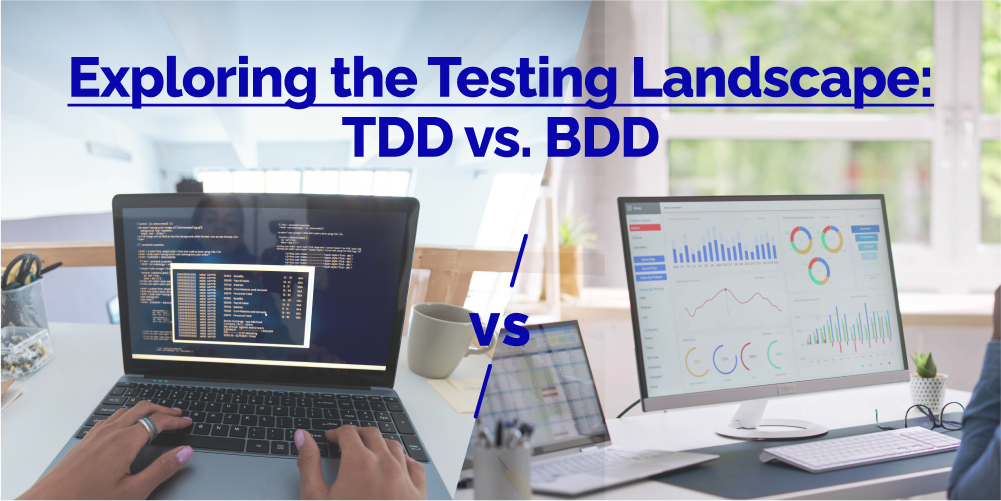Software Development, zBlog
TDD vs BDD: Choosing the Best Testing Strategy for Your Agile Projects
trantorindia | Updated: November 11, 2024

In the ever-evolving world of software development, quality assurance has emerged as a critical success factor. As applications become increasingly complex and user expectations for seamless experiences rise, the need for robust and efficient testing practices has never been more pronounced. Among the myriad of testing methodologies, two approaches have garnered significant attention and adoption: Test-Driven Development (TDD) vs Behavior-Driven Development (BDD).
While both TDD vs BDD share the common goal of improving software quality, they offer distinct perspectives and techniques. In this comprehensive blog, we’ll delve into the nuances of TDD vs BDD, exploring their definitions, core principles, practical applications, and the contexts in which each approach shines. Whether you’re a seasoned developer seeking to optimize your testing workflow or a newcomer eager to embrace best practices, this guide will provide you with a solid foundation for understanding and leveraging these powerful methodologies.
Test-Driven Development (TDD)

TDD is a software development practice that emphasizes writing automated tests before writing the actual production code. This seemingly counterintuitive approach is designed to foster a mindset of continuous testing, ensuring that the software being developed adheres to specified requirements and behaviors from the outset.
The TDD cycle consists of three fundamental steps:
- 1. Write a failing test: Before writing any production code, developers create a new test case that defines the expected behavior or requirement for the feature or functionality being implemented.
- 2. Write the minimum code to pass the test: Once the test is in place, developers write the bare minimum amount of code necessary to make the test pass, often resulting in a simple, straightforward implementation.
- 3. Refactor the code: With the test passing, developers can refactor the code to improve its design, remove duplication, and enhance maintainability, all while ensuring that the tests continue to pass.
This cycle is repeated for each new feature or requirement, gradually building a comprehensive suite of automated tests that serve as a safety net for future code changes and refactoring efforts.
Benefits of TDD:
- Encourages a modular, testable, and maintainable codebase
- Provides a safety net for refactoring and code changes
- Promotes a “red-green-refactor” workflow, fostering continuous improvement
- Enhances developer confidence and reduces the fear of breaking existing functionality
- Facilitates early detection and resolution of defects
Behavior-Driven Development (BDD)

While TDD focuses primarily on the technical aspects of writing tests and code, Behavior-Driven Development (BDD) takes a more holistic approach by emphasizing collaboration, shared understanding, and a focus on the desired behaviors of the system being developed.
BDD builds upon the principles of TDD by incorporating a domain-specific language (DSL) that allows stakeholders, including non-technical team members, to define and describe the expected behavior of the software in a natural, human-readable format. This DSL, often referred to as Gherkin, uses a structured syntax that follows the “Given-When-Then” pattern:
- Given: Describes the initial context or preconditions for the scenario
- When: Outlines the specific action or event that triggers the behavior
- Then: Specifies the expected outcome or result
By leveraging this structured language, BDD encourages collaboration between developers, testers, business analysts, and other stakeholders, fostering a shared understanding of the system’s requirements and expected behaviors.
Benefits of BDD:
- Promotes collaboration and shared understanding among stakeholders
- Facilitates clear and unambiguous communication of requirements
- Encourages a behavior-focused mindset, aligning development efforts with desired outcomes
- Enhances traceability between requirements, tests, and code
- Fosters a living documentation approach, where tests serve as executable specifications
TDD vs BDD: Similarities and Differences

While TDD and BDD share some similarities, such as their emphasis on automated testing and their iterative nature, they also have distinct differences in their approaches and focus areas.
Similarities:
- Both TDD and BDD emphasize the importance of writing automated tests
- They follow an iterative cycle of writing tests, implementing code, and refactoring
- They aim to improve software quality and promote a test-centric mindset
Differences:
- TDD is primarily focused on the technical aspects of writing tests and code, while BDD emphasizes collaboration, shared understanding, and a behavior-focused approach
- TDD tests are written from a developer’s perspective, while BDD tests are expressed in a natural language that can be understood by both technical and non-technical stakeholders
- BDD incorporates a domain-specific language (e.g., Gherkin) to describe expected behaviors, while TDD tests are typically written in the same programming language as the production code
- BDD fosters collaboration and communication among stakeholders, while TDD is more developer-centric
- BDD tests serve as executable specifications and living documentation, while TDD tests are primarily focused on verifying code functionality
Choosing Between TDD vs BDD

The decision to adopt TDD vs BDD depends on various factors, including the project’s complexities, team dynamics, and the specific goals and priorities of the organization.
TDD may be more suitable in the following scenarios:
- The project has a strong focus on technical excellence and code quality
- The development team is experienced with TDD practices and has a good understanding of the codebase
- The project has well-defined and stable requirements, with less emphasis on frequent changes or collaboration with non-technical stakeholders
BDD may be more advantageous in the following contexts:
- The project involves complex business requirements and a high degree of collaboration among stakeholders
- There is a need for clear communication and shared understanding of system behaviors across teams
- The project requires frequent changes or pivots in response to evolving customer needs
- The team values living documentation and traceability between requirements, tests, and code
It’s important to note that TDD vs BDD are not mutually exclusive; organizations can adopt a hybrid approach, incorporating elements of both practices to suit their specific needs and project requirements.
Integrating TDD and BDD for Maximum Impact

While TDD and BDD offer distinct perspectives and techniques, they can be combined to create a powerful synergy that amplifies their individual benefits and fosters a holistic, collaborative, and quality-driven development process.
By integrating TDD with BDD, developers can leverage the technical rigor of writing automated tests upfront while also benefiting from the clear communication of requirements and expected behaviors facilitated by the Gherkin syntax. This combination ensures that not only are the technical aspects of the system tested, but also that the desired behaviors and outcomes are accurately captured and verified.
One approach to integrating TDD and BDD is to use the “Outside-In” methodology, where BDD scenarios are written first, capturing the high-level behaviors and requirements. These scenarios are then used to drive the development of lower-level unit tests and production code using TDD practices. This approach promotes a seamless flow from high-level requirements to low-level implementation details, fostering alignment and traceability throughout the development lifecycle.
Practical Implementation and Best Practices

Implementing TDD, BDD, or a hybrid approach requires a structured approach and adherence to best practices:
- 1. Foster a Collaborative Environment: Encourage collaboration, open communication, and shared understanding among developers, testers, business analysts, and other stakeholders.
- 2. Adopt a Ubiquitous Language: Establish a common vocabulary and set of terms that accurately reflect the problem domain, ensuring consistency across teams and stakeholders.
- 3. Prioritize Test Automation: Invest in robust test automation frameworks and tools that support both TDD and BDD practices, enabling efficient execution of automated tests and streamlining the feedback loop.
- 4. Embrace Continuous Integration and Delivery: Integrate testing practices into a continuous integration and delivery pipeline, ensuring frequent execution of tests and providing rapid feedback on system quality.
- 5. Involve Stakeholders Early and Often: Engage business stakeholders early in the development process and maintain their involvement throughout, leveraging BDD’s ability to facilitate clear communication of requirements and expected behaviors.
- 6. Foster a Culture of Learning and Improvement: Encourage continuous learning, retrospectives, and iterative improvement cycles to refine practices, address challenges, and optimize the development process.
By embracing the synergistic power of TDD and BDD, organizations can cultivate a culture of quality, collaboration, and customer-centricity, ultimately delivering software solutions that not only meet technical requirements but also accurately reflect the real-world needs and expectations of end-users.
Conclusion
TDD vs BDD has emerged as a powerful testing methodology in the relentless pursuit of software quality, each offering distinct perspectives and techniques. While TDD emphasizes the technical rigor of writing automated tests upfront, BDD takes a behavior-focused approach, fostering collaboration, shared understanding, and a focus on desired system outcomes. The choice between TDD vs BDD, or a hybrid approach, depends on various factors, including project complexities, team dynamics, and organizational priorities.
At Trantor, we understand the critical role that effective testing methodologies play in delivering high-quality software solutions. Our team of experienced testing experts provides comprehensive guidance and support in implementing TDD, BDD, or hybrid approaches tailored to your organization’s unique needs.
From selecting the right testing frameworks and tools to fostering a collaborative, quality-driven culture, we partner with you every step of the way. Our expertise spans a wide range of industries and technology stacks, ensuring that our solutions align seamlessly with your specific requirements.
Don’t navigate the complexities of software testing alone. Partner with Trantor and unlock the full potential of TDD, BDD, and other testing methodologies. Together, we can elevate your quality assurance practices, drive innovation, and deliver exceptional software experiences that exceed customer expectations.




